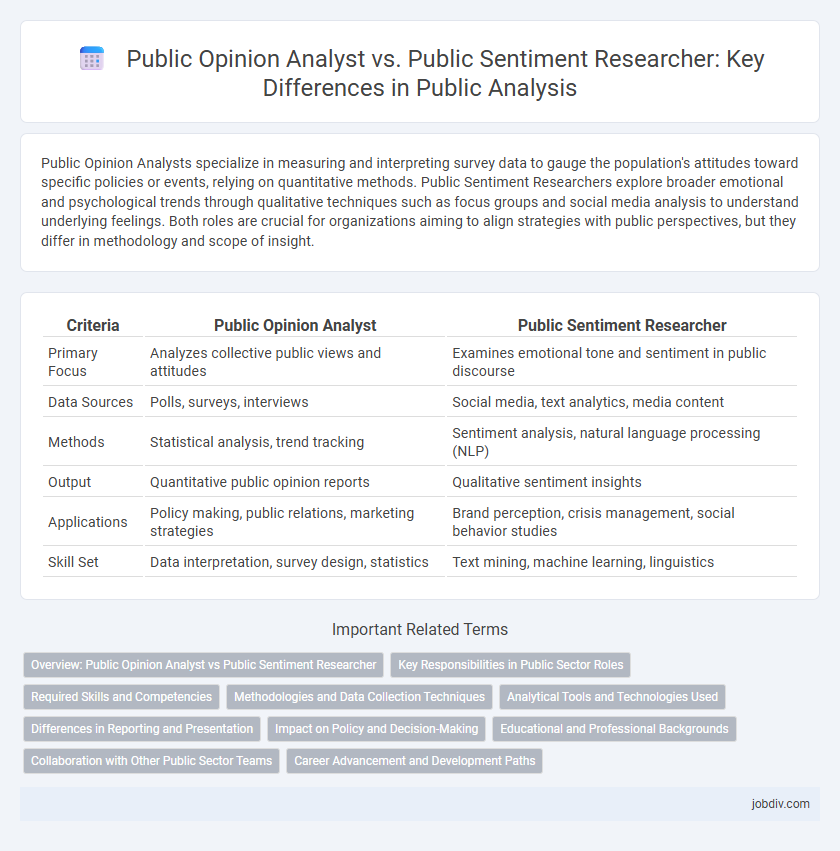Public Opinion Analysts specialize in measuring and interpreting survey data to gauge the population's attitudes toward specific policies or events, relying on quantitative methods. Public Sentiment Researchers explore broader emotional and psychological trends through qualitative techniques such as focus groups and social media analysis to understand underlying feelings. Both roles are crucial for organizations aiming to align strategies with public perspectives, but they differ in methodology and scope of insight.
Table of Comparison
| Criteria | Public Opinion Analyst | Public Sentiment Researcher |
|---|---|---|
| Primary Focus | Analyzes collective public views and attitudes | Examines emotional tone and sentiment in public discourse |
| Data Sources | Polls, surveys, interviews | Social media, text analytics, media content |
| Methods | Statistical analysis, trend tracking | Sentiment analysis, natural language processing (NLP) |
| Output | Quantitative public opinion reports | Qualitative sentiment insights |
| Applications | Policy making, public relations, marketing strategies | Brand perception, crisis management, social behavior studies |
| Skill Set | Data interpretation, survey design, statistics | Text mining, machine learning, linguistics |
Overview: Public Opinion Analyst vs Public Sentiment Researcher
Public Opinion Analysts primarily focus on gathering and interpreting quantitative data through surveys and polls to understand societal attitudes and trends. Public Sentiment Researchers utilize advanced qualitative and computational methods, such as social media analysis and natural language processing, to capture real-time emotional responses and public mood shifts. Both roles aim to inform decision-making, but Public Opinion Analysts emphasize statistical rigor while Public Sentiment Researchers prioritize dynamic sentiment insights.
Key Responsibilities in Public Sector Roles
Public Opinion Analysts in the public sector specialize in designing surveys, collecting data, and interpreting statistical results to gauge public attitudes toward government policies and programs. Public Sentiment Researchers focus on monitoring social media trends, analyzing qualitative feedback, and identifying emerging public concerns to provide real-time insights for policymakers. Both roles require proficiency in data analysis tools and an understanding of demographic factors influencing public perception.
Required Skills and Competencies
Public Opinion Analysts require strong skills in statistical analysis, survey design, and data interpretation to accurately gauge public attitudes using quantitative methods. Public Sentiment Researchers excel in qualitative research techniques, social media analytics, and natural language processing to interpret emotional and psychological drivers behind public behavior. Both roles demand proficiency in data visualization, critical thinking, and effective communication to translate complex findings into actionable insights.
Methodologies and Data Collection Techniques
Public Opinion Analysts utilize structured surveys, polling, and statistical software to gather quantifiable data on societal views, emphasizing representative sampling and trend analysis. Public Sentiment Researchers often employ social media analytics, natural language processing, and sentiment analysis algorithms to capture real-time emotional responses and nuanced public moods. Both roles rely on data collection techniques but differ in focus: traditional quantitative methods versus innovative qualitative and big data approaches.
Analytical Tools and Technologies Used
Public Opinion Analysts primarily utilize quantitative tools such as surveys, statistical software like SPSS and R, and data visualization platforms to measure and interpret public attitudes. Public Sentiment Researchers rely heavily on natural language processing (NLP), social media analytics, and machine learning algorithms to analyze large volumes of unstructured data from online sources. Both roles integrate advanced technologies, but Public Sentiment Researchers emphasize real-time sentiment extraction, whereas Public Opinion Analysts focus on structured data analysis.
Differences in Reporting and Presentation
Public Opinion Analysts emphasize quantitative data in their reports, using statistical charts and numerical scores to gauge public attitudes. Public Sentiment Researchers focus on qualitative insights, presenting narrative summaries and thematic analyses that capture emotional tone and underlying motivations. The presentation style of Analysts tends to be structured and data-driven, while Sentiment Researchers highlight context-rich, interpretive content.
Impact on Policy and Decision-Making
Public Opinion Analysts interpret survey data and polling trends to inform policymakers about prevailing attitudes on social issues, directly affecting legislative priorities and campaign strategies. Public Sentiment Researchers utilize social media analytics and natural language processing to capture real-time emotional responses, enabling dynamic adjustments in decision-making and communication tactics. Both roles significantly shape policy development by providing nuanced insights into public preferences and emotional undercurrents.
Educational and Professional Backgrounds
Public Opinion Analysts often hold degrees in political science, sociology, or communications, with extensive training in statistical analysis and survey methodology. Public Sentiment Researchers typically possess backgrounds in psychology, marketing, or behavioral science, emphasizing qualitative research techniques and sentiment analysis tools. Both roles require strong analytical skills, but Public Opinion Analysts focus more on quantitative data, while Public Sentiment Researchers prioritize emotional and attitudinal data interpretation.
Collaboration with Other Public Sector Teams
Public Opinion Analysts and Public Sentiment Researchers collaborate closely with government agencies, policy makers, and community outreach teams to ensure data-driven decision making. They share insights on public attitudes and social trends, enabling coordinated strategies across public health, education, and urban planning sectors. This collaboration enhances transparency and responsiveness in addressing community needs and improving public services.
Career Advancement and Development Paths
Public Opinion Analysts often advance by specializing in quantitative analysis methods and gaining expertise in demographic data interpretation, leading to roles such as Senior Analyst or Research Director. Public Sentiment Researchers typically develop career growth through mastering qualitative research techniques and social media sentiment tools, progressing toward positions like Sentiment Strategy Manager or Behavioral Insights Specialist. Both paths emphasize continuous learning in data analytics and communication skills to secure leadership roles in market research or policy advisory sectors.
Public Opinion Analyst vs Public Sentiment Researcher Infographic

 jobdiv.com
jobdiv.com